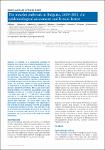The measles outbreak in Bulgaria, 2009–2011: An epidemiological assessment and lessons learnt
Muscat, Mark
Marinova, L.
Mankertz, Annette
Gatcheva, N.
Mihneva, Zefira
Santibanez, Sabine
Kunchev, A.
Filipova, R.
Kojouharova, M.
Measles re-emerged in a nationwide outbreak in Bulgaria from 2009 to 2011 despite reported high vaccination coverage at national level. This followed an eight-year period since the last indigenous cases of measles were detected. The Bulgarian National Centre of Infectious and Parasitic Diseases collated measles surveillance data for 2009–2011. We analysed data for age group, sex, ethnicity, diagnosis confirmation, vaccination, hospitalisation, disease complications, and death and describe the outbreak control measures taken. The outbreak started in April 2009 following an importation of measles virus and affected 24,364 persons, predominantly Roma. Most cases (73%) were among children < 15 years old. Vaccination status was available for 52% (n = 12,630) of cases. Of children 1–14 years old, 22% (n = 1,769) were unvaccinated and 70% (n = 5,518) had received one dose of a measles-containing vaccine. Twenty-four measles-related deaths were reported. The Roma ethnic group was particularly susceptible to measles. The magnitude of the outbreak resulted primarily from the accumulation of susceptible children over time. This outbreak serves as a reminder that both high vaccination coverage and closing of immunity gaps across all sections of the population are crucial to reach the goal of measles elimination.
Dateien zu dieser Publikation
Keine Lizenzangabe

